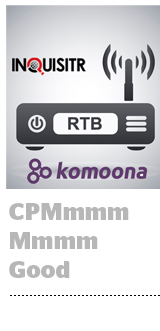 Most publisher sites are not oversubscribed – not by a long shot, said Amiad Solomon, chairman and co-founder of Komoona, a company that bills itself as an “RTB router.”
Most publisher sites are not oversubscribed – not by a long shot, said Amiad Solomon, chairman and co-founder of Komoona, a company that bills itself as an “RTB router.”
Solomon put it bluntly: “Publishers are bleeding.”
A lot of that has to do with the CPMs most publishers are able to attract for their non-direct programmatically sold inventory. Other than the super niche sites out there – cooking, health, parenting – or the premium players that everyone knows – the Wall Street Journals, CNNs and New York Times of the world – the average publisher has a lot of impressions that aren’t necessarily flying off the shelf.
All they want is the best price. But margins are low and the number of SSPs and exchanges out there is high.
Monetization can definitely be struggle, said Daniel Treisman, editor-in-chief of Inquisitr.com, a generalist news site covering trending topics, which garners between 30 million and 40 million mostly US uniques a month. The majority of its traffic, about 55%, comes from the mobile web, with desktop making up the rest.
“[We] find it challenging to devote the time needed to find the right monetization partners and strategies,” Treisman said. “There are a lot of moving parts and it feels like we are leaving money on the table due to the lack of time and know-how.”
Inquisitr uses the DoubleClick Ad Exchange for its yield management, but even Google doesn’t see everything. There’s also a potential inherent conflict in serving both the sell side and the buy side, said Komoona’s Solomon, who in a past life was the CEO and founder of brand safety and online semantic platform Peer39, which was bought up by Sizmek in 2012, when it was still known as DG, for $15.5 million.
“Google is a huge business, there’s no arguing about that, but what it can offer is limited to Google,” Solomon said. “What happens if somewhere else there’s someone bidding on an exchange at a higher price?”
That’s the question at the heart of Komoona’s tech. Komoona, which has been in semi-stealth mode until Friday, plugs directly into all the usual SSP and demand-side exchange suspects across display, mobile and video – including Rubicon, PubMatic, OpenX, Adap.tv, Smaato, Google AdX, of course, and a host of others – allows publishers to set a minimum floor price in its self-serve system.
From there, Komoona’s algorithm keeps an eye on the RTB landscape to determine which exchange is offering the highest CPM for a particular piece of inventory. Mindful of the publisher’s minimum, Komoona then sends the impression over to the higher bidder, whoever and wherever it might be.
The vision is to act as an “agnostic” layer between the publisher and the various SSP and exchange players, Solomon said.
“It doesn’t matter to us what type of media it is, be it mobile or video or display. The pipes may be different, but the algorithms are the same,” he said. “We’re just looking at performance at the impression level.”
But publishers still have to be realistic about their inventory. If a publisher sets a minimum floor price of $15, for example, but advertisers only value its audience or its content at $5 or less, that’s going to result in a pretty low fill rate. Komoona has an analytics layer as part of its UI that allows publishers to experiment and see the potential revenue results of different minimums before setting their floor price.
Inquisitr has been working with Komoona since 2013, and according to Treisman, he’s seen between 20% and 30% higher CPMs on its ad tags than with Google AdX.
“We can’t promise a publisher with inventory worth $4 that they’ll get $20,” Solomon said. “But we can guarantee that they’ll get the highest price the industry is willing to pay, regardless of where it’s sitting.”
Founded in 2011, Komoona spent its first two years of life building out its technology before hitting the market in 2013. The company, which Solomon said analyzes and processes about 20 billion impressions a month, has more than 1,000 clients, including publishers like Inquisitr.com, Radio.com, Lycos.com, The Nation and Publir, a publisher network that itself works with The Atlantic, RealClearPolitics, Tablet, Jewcy, The Week, Fark.com, Mental Floss and Fox News Radio.
Solomon, who founded Komoona with his brother Yair and COO Tzafrir Ben Ami, said the company is profitable. Komoona, which maintains an R&D center in Tel Aviv with about 20 employees and sales offices in New York, San Francisco and London, has no plans to go after external funding.














